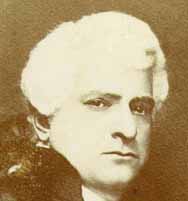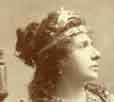Key Word Search
Multi-Field Search
Browse
Repertory Report
Performers Report
Contacts
Met Opera Website
United States Premiere, New Production
Tosca
Metropolitan Opera House, Mon, February 4, 1901
Tosca (1)
Giacomo Puccini | Luigi Illica/Giuseppe Giacosa
- Tosca
- Milka Ternina
- Cavaradossi
- Giuseppe Cremonini
- Scarpia
- Antonio Scotti
- Sacristan
- Charles Gilibert
- Spoletta
- Jacques Bars
- Angelotti
- Eugène Dufriche
- Sciarrone
- Lodovico Viviani
- Jailer
- Giuseppe Cernusco
- Conductor
- Luigi Mancinelli
- Director
- William Parry
- Costume Designer
- Engel & Co.
- Composer
- Giacomo Puccini
Tosca received seven performances this season.
Review 1:
Review of W. J. Henderson in The New York Times:
The performance of Puccini's "Tosca" presented in a new light that notable artist Milka Ternina. If the public is as hungry, as it seems to be for interesting artistic personalities, there is one upon which it can find itself to repletion. When this lady made her first appearance in New York in the early spring of 1896, she was warmly praised in this place for the beauty of her voice, and the exquisite smoothness and grace of her cantilena. At that time she was an actress of dignity, but not of power. Since then she has developed dramatically at some sacrifice of her former perfection of singing. At that time this writer expressed a doubt that her voice would prove large enough for such rôles as Isolde. That doubt has been justified, for in that role she is compelled at times to force the voice to attain a sufficient sound. This same difficulty interferes with her work in the rôle of Tosca, but it is not unjust to other admirable artists to say that there is no one now known to this public, expect possibly Emma Calvé, who could realize for us the operatic Tosca as Miss Ternina has done, and Mme. Calvé could not sing the music.
In the purely technical matters of makeup and dress, alone Miss Ternina has revealed unsuspected taste and skill. Her gowns in the first two scenes are marvels of characterization in costume. In both she looks the Roman singer, while the second is so cunningly designed as to preserve the character and add to it the dignity of tragedy. Her comedy acting in the first scenes is delightful in its sincerity and in certainty of touch, while in the passionate emotions of the second act she rises to heights not excelled by her in any of her other parts. And she individualizes her Tosca. There is not a suggestion in it of her Brünnhilde or her Isolde. It stands on a separate and clearly drawn identity. This is a demonstration of high art. But for the singing this is good, but it is not unique. Miss Ternina's acting is what makes her Tosca a splendid addition to our operatic acquaintances. The singing would count for her more if Puccini had written more music of an effective sort. In the one cantabile of the second act Miss Ternina makes a fascinating point, and on the first night the unreasonable Italian contingent, which still persistently refuses to accept an opera as a drama, would wish to have encored it. Miss Ternina, being a true artist, paid no attention to the cheers and shouts of "brava."
Mr. Scotti's Scarpia is a brilliantly vigorous and aggressive impersonation. His voice is admirably suited to the music, and he sings his measures with a full appreciation of the brutality of the nature of the creature he represents. His acting is always good, and he makes the second act impressive. Mr. Cremonini is not an actor, but he is singularly well suited to the rôle of the slight and impulsive Cavaradossi. His voice, too, suits the character of the rôle excellently, and so without any special effort on his own part he fills the picture fairly well. He might easily be more touching in the last act, but that would require some subtlety, of which he is quite innocent.
Review 2:Review of Henry Krehbiel in the New York Tribune:
Much of it [is] like shreds and patches of many things with which the operatic stage has long been familiar. There are efforts at characterization by means of melodic, harmonic, and rhythmical symbols, of which the most striking and least original is the succession of chords which serves as the introduction to the first scene. This and much else came out of Wagner's logical mind, either in the choice of the material or its development. Phrases of real pith and moment are mixed with phrases of indescribable balderdash, yet these phrases recur with painful reiteration and with all the color tints which Puccini is able to scrape from a marvelously varied and garish orchestral palette. The most remarkable feature of it all, the one which shows the composer's constructive talent in its highest aspect, is the fluency of it all. Even when reduced to the extremity of a tremolo of empty fifths on the string pianissimo, or a simple sustained tone, Puccini still manages to cling to a thread of his melodramatic fabric, and the mind does not quite let go of his musical intentions. The real melos of the piece from the beginning to end is of that hot blooded passionate type which came in with Mascagni and will probably not go out until composers as well as public have wearied of melodrama and returned either to the lyric drama or opera.
Photograph of Milka Ternina as Tosca by Aimé Dupont.
Photograph of Antonio Scotti as Scarpia by Burr McIntosh Studio. His 217 performances of Scarpia are a Metropolitan Opera record for performances by an artist of a leading role.
Search by season: 1900-01
Search by title: Tosca,
Met careers
- Milka Ternina [Tosca]
- Giuseppe Cremonini [Cavaradossi]
- Antonio Scotti [Scarpia]
- Charles Gilibert [Sacristan]
- Jacques Bars [Spoletta]
- Eugène Dufriche [Angelotti]
- Lodovico Viviani [Sciarrone]
- Giuseppe Cernusco [Jailer]
- Luigi Mancinelli [Conductor]
- William Parry [Director]
- Engel & Co. [Costume Designer]
- Giacomo Puccini [Composer]

